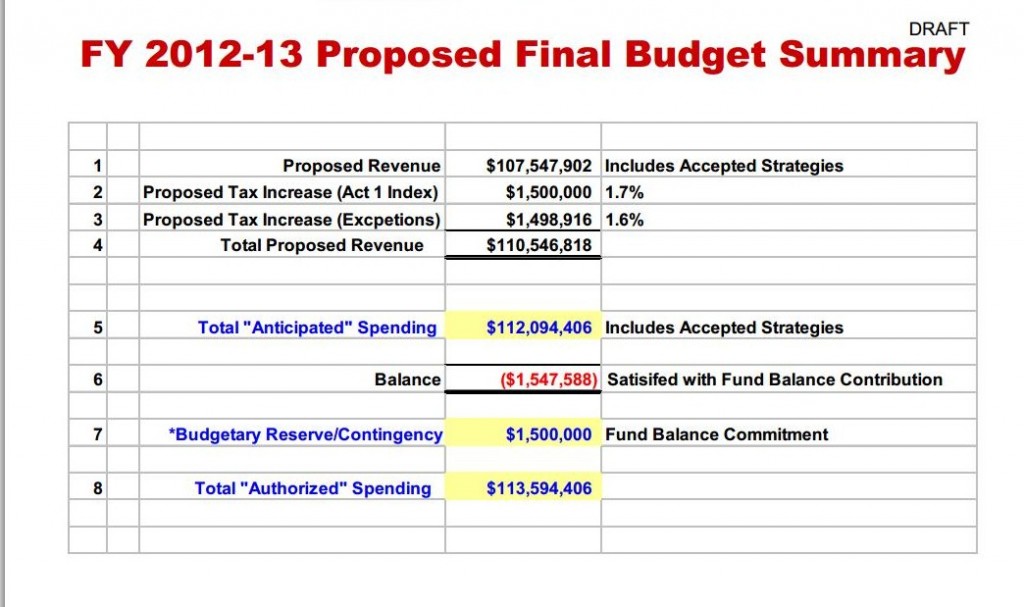Should school districts, such as TESD use fund balances instead of educational cuts and teacher demotions? The answer according to Governor Corbett and some other Pennsylvania lawmakers, is yes.
Tredyffrin Easttown School District has amassed an enviable fund balance – $32 million; one of the largest in the state. There are those in the community that support the school board holding on to the “rainy day” reserve funds; primarily because of the dramatically increasing PSERS contributions over the next few years. We understand that the traditional package of retirement benefits for state employees and teachers has become unaffordable and pension reform is sorely needed (and sooner rather than later). I support the state switching to a defined-contribution model (401(k) type model) for new hires but that only prevents the underfunded-pension liability problem from worsening … the state has a current multi-billion dollar hole. But unlike T/E, the state has no “rainy day” fund. Trying to manage their budgets, the state’s pension crisis has pushed school districts across the state to the edge of the cliff. There are those that praise T/E for the good job they have done in holding onto their fund balance in spite of the pension crisis.
But not everyone in our school district supports T/E holding onto the $30+ million fund balance; suggesting that this money represents past overtaxing and belongs to the taxpayers and should be returned. Then there is the teacher union’s position that the fund balance should be used before utilizing budget strategies such as demotion or increasing class size. Some residents fear that as school district’s budget woes push them over the cliff, the state will look to Districts (such as T/E) to bail out their fellow school districts.
Governor Corbett has sent a message to Pennsylvania’s school districts; he believes that they should tap into their reserves instead of cutting programs or laying off teachers and staff. During a recent radio interview with Dom Giordana on CBS channel WPHT, Corbett said if school boards want to cut programs instead of spending more of their financial reserves, than the public should blame them – not his budget. According to Corbett, “Well, I look at the reserves as – it’s a rainy day fund. And this is a rainy day – we are in a rainy day.” If you are a supporter of our governor, then the message to T/E school board would be no educational cuts, spend the fund balance.
Taking Gov. Corbett’s message for school district’s to use their fund balances, a step further are State Rep. Mike Vereb (R-Montgomery County) and Mario Scavello (R-Monroe County). These two Republican lawmakers are developing legislation that would force school districts to use their reserve funds to balance their budget before they would be allowed to raise taxes. Vereb and Scavello want to either limit the amount of money that districts can hold in their “rainy day” reserves or ban the school districts from raising taxes if the money needed to balance the budget is available (in the fund balance).
In an article on Watchdog.org , “Pennsylvania School Districts have Tripled Savings in 15 Years”, it was stated that Pennsylvania school districts have more than $3.2 billion in reserve funds. Data from the PA Department of Education indicates that the reserve accounts have nearly tripled from $1.1 billion in 1996-97 to more than $3.2 billion last year.
The article included an interesting table listing the largest reserve fund increases in Pennsylvania since 1996-97; Tredyffrin Easttown School District has the distinction of coming in 7th in the state. In 1996-97, T/E had $4,333,661 and in fifteen years increased by more than $26 million to a current total of approximately $32 million. Amazing.
| Largest Reserve Fund Increases Since 1996-97 | |||||
| Rank | District | 1996-97 | 2010-11 | Increase | |
| 1 | Pittsburgh | $47,013,209 | $148,871,185 | $101,857,976 | |
| 2 | Downingtown | $183,005 | $50,803,447 | $50,620,442 | |
| 3 | Abington | $1,509,021 | $45,937,675 | $44,428,654 | |
| 4 | Lower Merion | $6,584,556 | $43,405,136 | $36,820,580 | |
| 5 | Altoona | $1,509,021 | $45,937,675 | $44,428,654 | |
| 6 | Bensalem | $1,674,721 | $28,564,360 | $26,889,639 | |
| 7 | Tredyffrin-Easttown | $4,333,551 | $31,026,455 | $26,692,904 | |
Vereb is “furious to find that many of the state’s school districts that are crying poor and blaming the state for their fiscal problems are sitting on surpluses, including one that totals $148 million.” Although Vereb supports school districts having an emergency reserve, he feels that the taxpayer is deserved an explanation as to why school districts with large fund balances are cutting programs and teachers and raising property taxes but refusing to use fund balances. That’s the reasoning behind the legislation that he and Scavello are working on — forcing the hand of school boards to use their fund balances before raising taxes.

